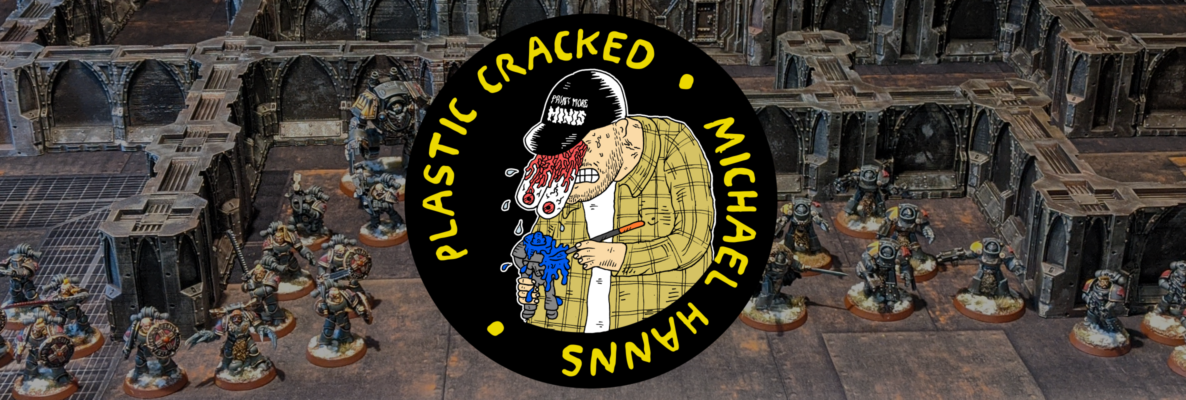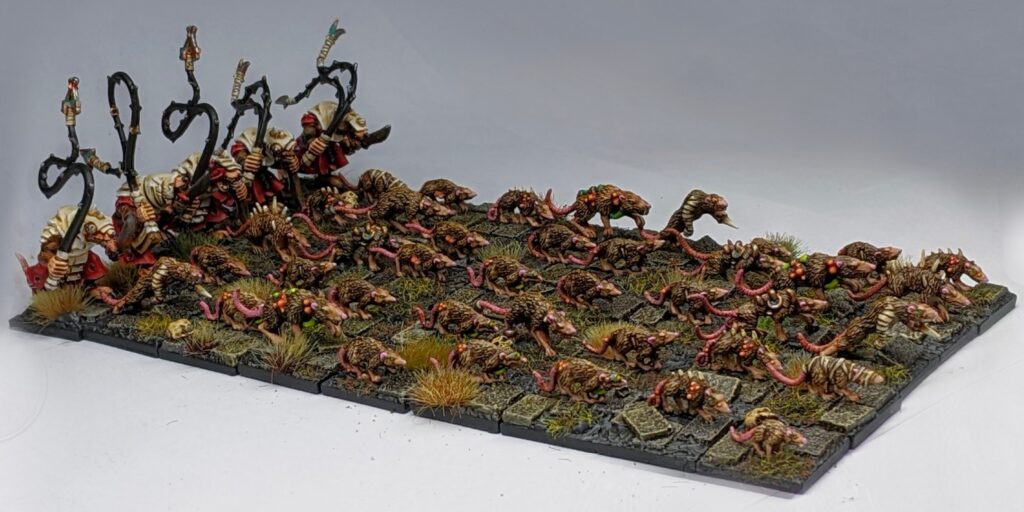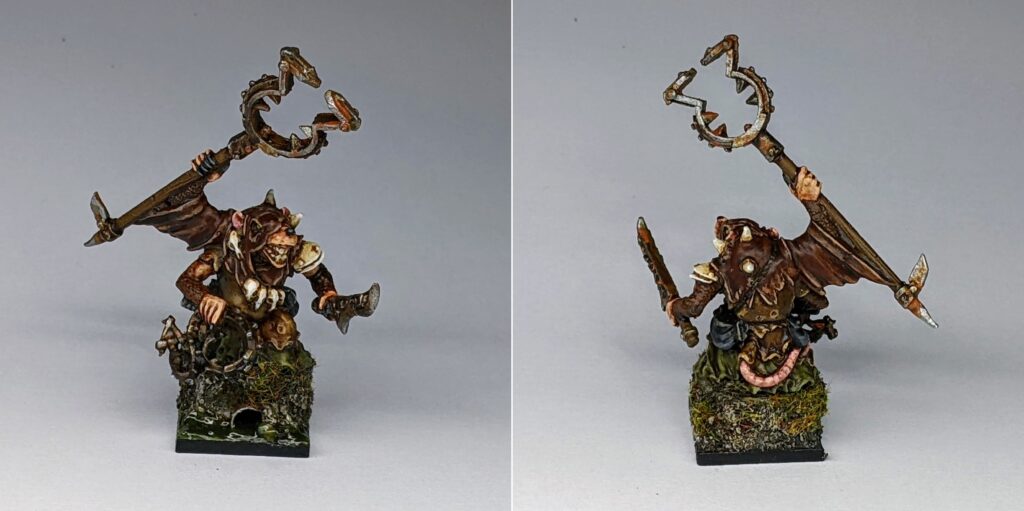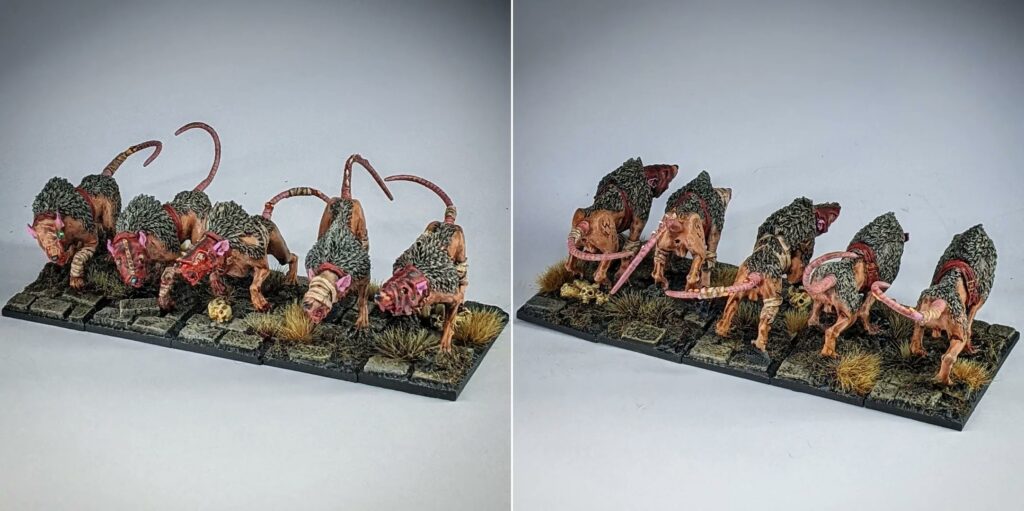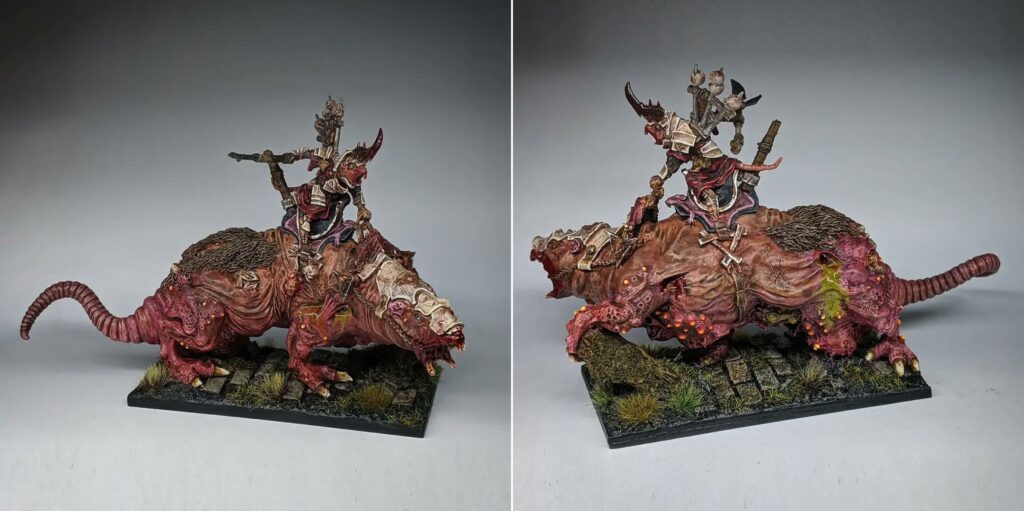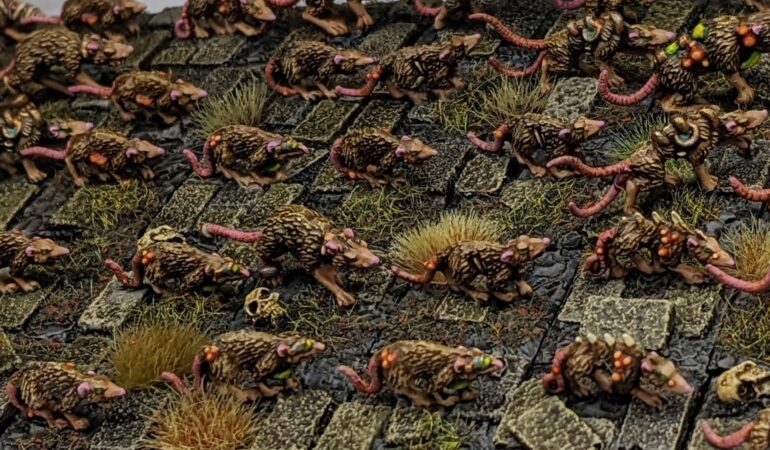
So much for hitting the ground running on a New Year, New Army project.
I really should have learned by now not to bother mentioning what I’m working on next – I almost always end up doing something completely different. At least this time I really did manage to make a start on my Rohan army – no, really, I have proof – but sometimes, things just don’t go according to plan.
It wasn’t the fault of the miniatures. Assembling the Rohan minis could’ve been more exciting, sure, but there wasn’t some big frustrating moment that made me put the project aside. Instead, I just had this nagging feeling telling me that I was forcing things. I wanted to get swept away in the hype of a New Year, New Army project, but instead it seems I had some unfinished business with the Skaven.
Unlike the last entry of Vermintide which was a little all over the place in terms of unit selection, this entry has a more consistent theme – Clan Moulder. Moulder is one of the least represented Clans in my collection, and unlike Clan Eshin – whose units consist only of characters, Night Runners (no ta) and Gutter Runners – there’s quite a lot I could yet do to remedy this. From a 6th Edition point of view, my army is missing a Master Moulder character, as well as a unit of Giant Rats – the latter of which I already own plenty of thanks to my numerous Rat Ogre and Plague Monk sprues. In 7th and beyond, the army could certainly do with a Hell Pit Abomination to fill up one of the Rare slots. Spicier still, the Monstrous Arcanum features rules for both Brood Horrors and Wolf Rats – a pair of units I own from back when my Skaven were a part of a larger Age of Sigmar Khorne army. Ah, simpler times.
Let’s start small and work our way up, shall we? The first addition to Clan Moulder is their core troops – Giant Rat Swarms.
Now that I’m building this army to work in some capacity across 6th, 8th, KoW and T9A, I need to factor in how army building works across all of these systems and army lists. 6th WHFB is the most forgiving from a model count perspective, though it does require exactly one Packmaster for every 6 Giant Rats. While 8th and T9A tend towards bigger unit sizes, 8th wants at most one Packmaster for every 6 Giant Rats while T9A is a straight up 10-30 Giant Rats – no need for Packmasters at all.
To paint, the Giant Rats were every bit as quick and easy as you might expect. A zenithal baecoat of Beasty Brown and Khaki and a drybrush of Elfic Flesh to pick out the fur, a quick basecoat of Heavy Skintone for the legs and face, Squid Pink for the tails and ears, then an all over wash of Seraphim Sepia. Once dry, I’d do a quick and simple layer and highlight of Heavy Skintone and Rosy Flesh for the skin. For some of the simpler rats, all that remained was to quickly pick out the teeth and eyes then paint the base. Others necessitated a little more faff, such as picking out some bandage wraps with Elfic Flesh, painting pustles with layers of Blood Red, Firey Orange and Plague Yellow or little warpstone crystals and cabling using Mutation Green, Lime and a bit of Bald Moon Yellow. Still, nothing too taxing, and these more interesting Giant Rats really do help add a little flair and variation into the unit.
After a little rummaging around old sprues, I managed to salvage around 40 Giant Rats and 5 Packmasters without resorting to conversions. This was.. pretty perfect, to be honest. That would make a good sized unit for 6th Edition, with the option for greater numbers in 8th.
Now that I had both Giant Rats and Rat Ogres in my army, it seemed only logical that I’d paint up a Master Moulder character to complete the 6th Ed army list – and what better Master Moulder than Throt the Unclean himself?
Since Throt was a named character, I decided to give him a little elevated base similar to my Lord Skrolk or Skaven Warlord minis1. This base style is simple – it’s three layers of corkboard, with some sand and debris super glued around it to make it look a bit less obviously like corkboard. While I was putting this one together, I noticed a little bit of tubing on my desk from a paintbrush. It gave me the idea to put a little pipe there at the bottom of his base for added ‘hell pit’ vibes. I’m pretty happy with the result.
I decided to take another cue from Lord Skrolk2 here and paint Throt in his drab browns and olive tones, rather than the red and ivory of my armies scheme – he is a named character with his own history, clan and agenda, after all3. The bottom of his skirting I painted Heavy Grey, while the rest of his robes were Khaki and Dark Fleshtone, with Beasty Brown for his fur. One concession I did make to tie him in with the rest of the army was painting his metal pauldron ivory like the armour of my Clanrats. Nothing else to say about this paint job, really – it was quick, easy, and quite gratifying.
Speaking of quick, easy and gratifying – I decided to take this opportunity to seize a couple of easy wins and port another pair of Skaven units over to squares. The first of these were a small pack of Wolf Rats.
I’ve had these Wolf Rats for a long time now – they made their first appearance as part of my first Age of Sigmar army, The Wolf and the Rat all the way back in 2016. They didn’t really do much as part of that army (besides helping to tie my laborious theme together), and I’m not sure 5 of them will make much impact in this army either. Regardless, they’re cool miniatures and they’ll look good as part of the Clan Moulder section of my army.
These minis have already undergone one rebasing already when the army pivoted from a Khorne/Skaven combined arms to a pure Skaven force for Age of Sigmar, which meant rebasing them now was a little less trivial than I’d hoped. Their paws were buried under mounds of texture paint, and the feet are also cast onto little snowshoes for adhering the base, meaning they were really stuck to their little plastic round bases. I got there in the end, but I did end up needing to apply a little texture paint to the new bases to fill gaps and hide areas of damage. Additionally, a lot of paint got pulled off on their legs digging them up, so a number of legs needed a quick basecoat, wash and highlight paint job repair.
This was trivial however compared to rebasing my Skaven Warlord on Brood Horror.
Oh man. Once upon a time, this model was my pride and joy. It was my first ever ForgeWorld purchase; I bought it so that my Khorne Bloodbound/Skaven army would have a cool centrepiece to match the Stardrake of my Stormcast Eternals. I just loved the aesthetic of the model, the gritty detail of ForgeWorld resin and the little horrible features like a little rat crawling out of a hole in the Brood Horrors back. I loved this model so much that when it was time to sell that army, I couldn’t part with this miniature. Instead, I made the decision to hold onto the Stormvermin, Wolf Rats and Brood Horror and build up a Skaven army for Age of Sigmar.
At this point, I decided to abandon the ‘Realm of Fire’ basing scheme for the army and instead pivoted everything to brown, muddy bases. The Brood Horror even received one of my first ever attempts at a resin cast ‘water’ base. Given my track record with pouring resin, it’s probably no surprise that it was something of a disaster – and it made rebasing this model all the more difficult. I had to clip apart the resin and break his poor legs free, ripping off a good amount of paint and requiring some ‘corrective surgery’ in the process.
You may also notice that the pole holding up the Skaven icon on the back of the saddle is snapped – this was because back when model was in a Khorne army, I had replaced the Horned Rat icon with the Khorne symbol from Khorgos Khul’s shoulders. This obviously wouldn’t do for a ‘proper’ Skaven army, so it was snapped off altogether and presented like it was damaged.
Man, what a mess. Still, I love this miniature – and the paint job holds up surprisingly pretty well to my standard of painting now, despite it’s age. I’m also fairly certain that it’s out of production now, and usable as a type of Arena Beast in 9th Age – bonus.
To rebase him, I had to clip away at the resin, cracking off a shards at a time until his feet were finally free – at the cost of a broken foot and a ton of painted peeled off from his legs and belly. Fortunately, none of this was especially difficult or time consuming to repair. While I was fixing things, I decided to pin both sides of his halberd to his hand to stop the shaft from snapping off if you look at it the wrong way.
And since we’re on the subject of big, horrible monstrous creatures – let me introduce you to the last thing I painted for Moulder Month – Fluffy, the Hell Pit Abomination.
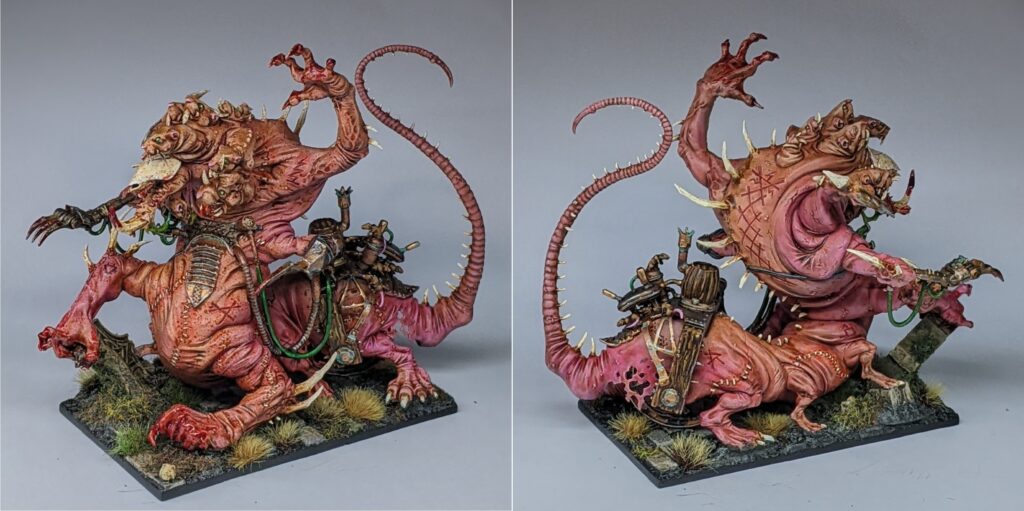
I’ll be honest – I was a little bit intimidated to paint this guy at first. He’s huge, he’s fleshy and he’s absolutely covered in cool little details. The GW webstore offers a few interesting suggestions as what colour to paint him, but in the end I decided to take inspiration from my Brood Horror above – and see how well I could pull off that scheme five years on.
Given the size of this monstrosity, I figured I’d get a good amount of mileage out of airbrushing the base volumes on this miniature. I started from grey primer, followed by an all over coat of Vallejo Game Air Flesh. From here, I airbrushed Game Air Pale Flesh zenithally over any protruding areas – his chest, back, head(s) and raised arm in particular. I then took another pass or two of Pale Flesh over the heads and chest (as these areas would be the least concealed by other parts of his body), taking greater care to build up this lighter tone above and in front of the faces to leave a shadow effect beneath.
When I was happy that the flesh tone was consistent and the volumes ‘lit’ adequately, I moved onto tinting the limbs in that same angry pink tone as on the Brood Horror. For this, I used Game Air Warlord Purple very carefully through the airbrush, moving from the start of the limb towards the end, gently increasing the amount of paint coming through the airbrush. I made a few passes like this to build up the colour – taking care not to apply too much with any one layer that I lose all of the pre-shading I did with Flesh/Pale Flesh.
Before cleaning up and putting away the airbrush, I threw a bit of Game Air Squid Pink into the cup and sprayed the tail from bottom to top – giving it a very gentle gradient from the reddish pink to lighter pink as the last traces of Warlord Purple left the cup leaving pure Squid Pink.
These airbrushed volumes helped sketch the basic colour transitions and where the lighting was going, but it didn’t really pick out much of the texture in the skin or help shade between the folds of flesh. To achieve this, I did a couple of things. First of all, I took out a reasonably large round tipped drybrush, dipped it into some Vallejo Game Pale Flesh and started drybrushing this across everywhere that wasn’t pink-tinged. As this colour matched the highlight colour I’d used in the airbrush, it blended perfectly with the airbrushed skin volumes. This additional layer of paint meant that even the areas I’d targeted with the airbrush were pushed further toward Pale Flesh, while the shaded areas benefitted from some pop to their texture but still looked proportionally darker. The purple areas received a similar sort of drybrush, this time made from a mixture of Warlord Purple, Squid Pink and a tiny bit of Pale Flesh to keep everything tied together.
Things were looking pretty good after the drybrush, but before I moved onto shading I wanted to spend some time picking out some of the focal points of the skin. In particular, I layered up some of the folds and veins around the lower chest and arms with Pale Flesh as well as applying some highlights to the many heads on this thing. Since the horrible array of heads is where everyone was going to look first on this model, I pushed these highlights a little further all the way up to Elfic Flesh for maximum ‘pop’.
Finally, it was time to throw a wash on the skin. I always like to add this step at the end – particularly on models with large areas of flesh like this one. Beyond shading the folds and emphasising detail and texture, it also helps to blend the highlights together and knock off some of the ‘chalky’ effect created by the drybrushing. I made a mix of two parts Seraphim Sepia, one part Reikland Fleshshade and one part Lahmian Medium then applied it over the entire model, taking care to get it over every surface, into every nook and cranny. I let it dry just long enough that the wash had started to settle – past the point where the wash still ran but before any pooling areas had began to cure properly – then I took a clean, dry brush and used it to soak up any excess wash that had pooled. This was to be the ‘final layer’ on the skin, so I wanted it to look as clean as possible and minimise any tide marks from the wash.
With the wash dry, the skin was finished and all that was left really was little details. Wood was painted Beasty Brown, highlighted with Leather Brown and Elfic Flesh and then washed with Seraphim Sepia. Metal was painted Chainmail Silver or Brassy Brass, washed with Agrax Earthshade, layered up, pin washed with Ryza Rust and Nihilakh Oxide and highlighted with Shining Silver. Cables were also painted silver in this fashion before receiving a couple thin coats of Waystone Green Gemstone Paint (lightened up with a little Yellow ink). Bones, teeth and claws were picked out with Elfic Flesh and White before getting dulled back down by a little Seraphim Sepia wash. Eyes were picked out with Vallejo Game Goblin Green, highlighted with Vallejo Model Lime Green and Elfic Flesh, then washed with Biel Tan Green.
The last step, in my opinion, really finished off the model – I took out my pot of Bloodletter Red and very lightly glazed over the scarring detail on the model. This includes the little Horned Rat symbols on his chest and thigh, the symbols on his back and all of the areas that were stitched together. Anything recessed was allowed to pool just a little bit, while just a little hint of the glaze was spread thinly on around the edges. This gave the skin around the scars and stitching an angry, inflamed look to it. Finally, I very carefully picked out the stitches in Elfic Flesh to finish it off. The model was complete – and with it, my Month of Moulder!
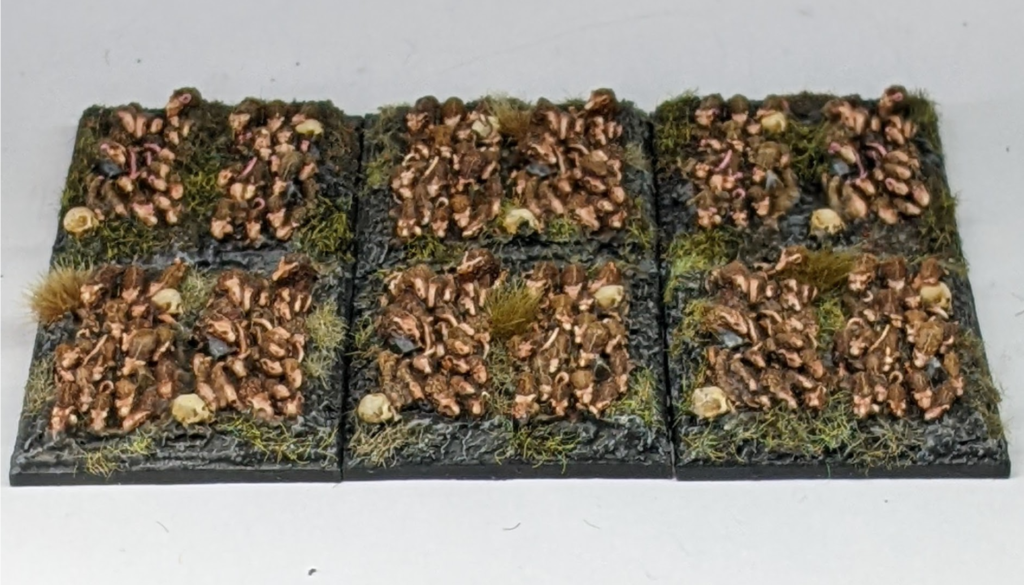
I have to say, I’ve had an absolute blast painting Skaven this past month. There’s something about the continued expansion of an army that’s already got a strong core to it that just feels good. Maybe it’s the lack of pressure; if an army is already playable, then everything else is just gravy. Perhaps it’s the familiarity of the process – the colour scheme, the models, what works and what doesn’t. Heck, it could just be that I love Skaven. After all the work I’ve put into getting the backbone of the army ready, it’s been an absolute joy to finally tick off some of the weird and wonderful elements of the range that make Skaven so fascinating. I’m excited to see more and more diverse units such as Giant Rats and Hell Pit Abominations appearing between my blocks of Clanrats and I can’t wait to see how the full army has grown since the last family photo.
But there’s no sense in taking that photo just yet – because there’s more Skaven to come! After having had so much fun with Moulder Month, I’m planning some further reinforcements from all4 of the major clans. Next up are the deadly and unstable creations of Clan Skryre, so keep your eyes peeled for that.
Until then, thanks for reading and happy wargaming!
1 Admittedly, the reason Skrolk and my Warlord are on tall bases is to help them fit better in a regiment of Plague Monks or Stormvermin, respectively. That being said, I do think the elevated mound does a good job of making them stand out nicely as characters – I think I’ll continue in this fashion with all named characters or mighty Lords of the Clan. Uh.. Remind me to rebase Thanquol.
2 Again, Lord Skrolk being painted in a more traditional green than the grimy ivory robes of the rest of my Pestillens minis wasn’t a conscious choice – he started life as a Plague Priest for my Maggotkin of Nurgle army many, many moons ago and was rebased over to join the vermintide as an easy win.
3 Uh… Maybe I should repaint Thanquol in grey robes?
4 Full disclosure, after the addition of another 6 Gutter Runners in my last post, I don’t really have a whole lot more than I want to add from Clan Eshin – I already have an Assassin and as many Gutter Runners as I need for now, and I have no interest in adding any of the old Monkey Rat Night Runners to the army. That being said, with Throt the Unclean and Lord Skrolk making appearances in my army, I’d be remiss not to add Deathmaster Skritch. For now, the plan is to fold him into my Clan Verminus month.
